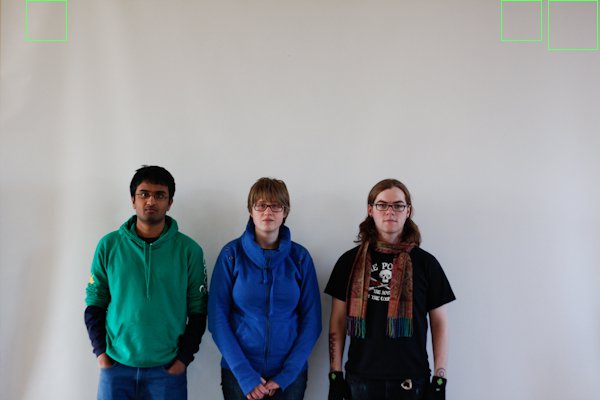In this project, we applied PCA (Principal Component Analysis) to create a face
recognition system. For this problem, we reduce each face image into a vector and
then use PCA to reduce the dimensions of the vectors. This reduction can occur
because valid faces only exist within a small subspace of the full vector space.
By finding this reduced space, the corresponding eigenvectors (in this case called
eigenfaces) which define this space, can be used to describe each face. Then by
comparing
Debugging turned out to be quite a challenge, until I created a debugging image that displayed
the calculated error scores for each face window for each scale. This allowed me to see
what the actual reasons were for false positives and negatives. In my particular case I
had forgotten to initialize a number of Face objects, which caused random noise to appear
within my results.
Testing is much easier with automation. Writing scripts proved to be very valuable.
Addtionally, comments are extremely important. Reading through code to find understanding
can be time-consuming and error-prone.











Face Recognition for 10 Eigenfaces
When using the 10 25x25 eigenfaces, the program correctly recognized 23/33 of the
cropped, smiling students to their corresponding cropped, non-smiling photo. Three of
the mismatches are displayed below:






Correct Recognition vs Number of Eigenfaces

For this experiment I created a batch script which for each necessary 25x25 eigenface
number (10 or 1-33 odd) first calculated the eigenfaces and userbase using the following
commands:
main --eigenfaces NUM 25 25 nonsmiling_cropped\list.txt eigNUM.face
main --constructuserbase eigNUM.face nonsmiling_cropped\list.txt userNUM.user
Then, for each cropped smiling image, I ran the --recognizeface command. Like the
following command:
main --recognizeface smiling_cropped\IMG userNUM.user eigNUM.face 1
Then, I counted the number of correct face matches for each eigenface count and
generated the plot using Excel.
Question 1: The plot shows that the number of matches initially increases with
the increase of eigenfaces. However, the increase quickly tapers off. This suggests
that simply increasing the eigenface count does not generally improve the quality
of matching. So, best eigenface count choice appears to be between 5 and 9
eigenfaces because it produces it costs less computation time than 33 eigenfaces
and produces nearly the same results. The reason why the "best" number of eigenfaces
is so small may be attributed to the small image base, since there are only 33 images,
the later eigenfaces are less and less meaningful.
Question 2: Of the ten mistakes when using the 10 25x25 eigenfaces, all of the errors
seemed reasonable. These mismatched images all had very strange facial expressions,
that deviated a lot from the corresponding neutral expressions. The corresponding neutral
face generally appeared within the top 5 matches, which seems reasonable.
For this experiment, I simply used the --findface command to test my program's face
recognition. I tested various parameters in order to receive an accurate result.
Cropping the elf.tga image

For this part, I used the following command to crop the image shown above:
main --findface elf.tga eig10.face 0.45 0.55 0.01 crop1 result_elf.tga
This results in the following cropped image:

These results are what I would expect. The program does in fact recognize
the baby's face.

Question 1: For cropping my face from the above image, I used the
following parameters:
min_scale = 0.05, max_scale = 0.15, scale_step = .01
This produced, a nice crop of my face, which is shown below:

Question 2: Initially, I had allowed the max_scale value to be larger. In this
particular error, 0.15. This bad face match is shown below:

This caused the result to be focused on my bangs, just capturing my eyebrows.
This mistake might have occurred because there is a dark shadowing in my hair right
where the "eye" region of this image would be. My guess is that this shadowing caused
it to have a reasonable score, plus the fact that my hair is very pale in this photo
and likely a reasonable approximation to a skin tone doesn't help either.
Cropping a group neutral image

Question 1: I tested face recognition on the third neutral group image. To
produce the image with correct face recognition shown above, I used the following
parameters:
min_scale = 0.5, max_scale = 0.8, scale_step = .1
Question 2: In this case, I did not provide small enough face sizes to
have the actual faces recognized. I originally had the max_scale set to the smaller
value of 0.6. The incorrect face recognition image is shown below:

By having too small of a max_scale value, the tested face windows were too large
in comparison to the actual faces. This caused the faces to be overlooked, while
the upper portions of the screen were selected. These selections are likely caused
by the low variance of the face windows, as well as the slight shadowing within each
window.
Cropping an image of hobbits

Question 1: For my second group image test, I took an image of the hobbits
from The Lord of the Rings. To produce the accurate face recognition shown above, I
used the following parameters:
min_scale = 0.85, max_scale = 0.85, scale_step = .1
Question 2: While I was trying to figure out the scale that corresponded to
the faces in the image, I ran into a number of false positives. One of these instances,
is shown below:

In this case I used the following parameters:
min_scale = 0.5, max_scale = 0.7, scale_step = .1
In this case, I resulted in two false positives. Merry and Pippen's faces were
not recognized. I think this is partially due to their small face sizes, in comparison
to the window. I think the false matches ranked highly for different reasons. The false
match that was largely made of the white background, was likely chosen for its very low
variance. The only variance within the image exists in the bottom left corner. The reason
for Frodo's sleeve being detected as a face, is likely due to the shading within the region
as well as the level of red coloring, since I weighted red to be more important than green
or blue.



























 class="label">
class="label">